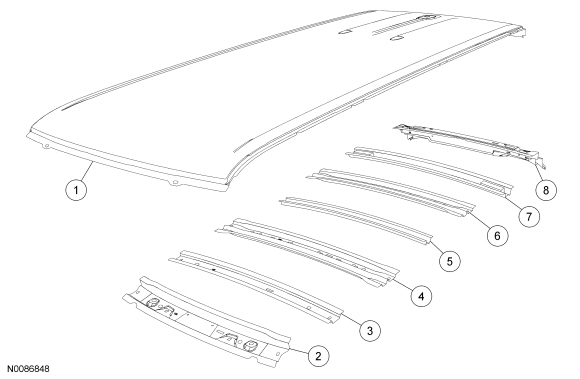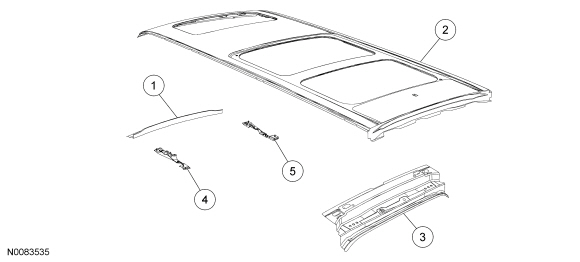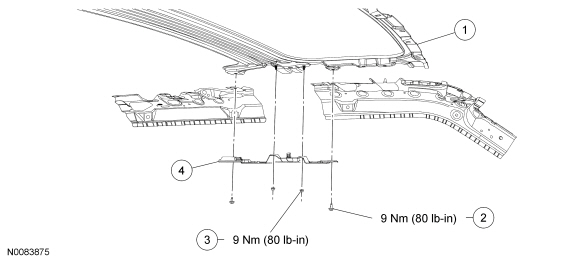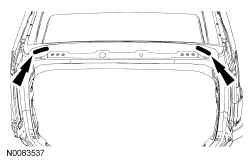SECTION 501-35: Body Repairs
| 2014 Flex Workshop Manual
|
REMOVAL AND INSTALLATION
| Procedure revision date: 05/02/2013
|
Roof Panel
General Equipment
| 3 Phase Inverter Spot Welder 254-00002
|
| I4 Inverter Spot Welder 254-00014
|
Material
| Item
| Specification
|
|---|
Flexible Foam Repair
Fusor® 121
| —
|
Motorcraft® Seam Sealer
TA-2
| —
|
Roof Exploded View

| Item
| Part Number
| Description
| | 1
| 50202
| Roof panel — mild steel
|
| 2
| 403410
| Windshield header — High-Strength Low Alloy (HSLA) 350 steel
|
| 3
| 450263
| Roof bow at A-pillar — mild steel
|
| 4
| 451510
| Roof bow at B-pillar —
550 steel
|
| 5
| 513F00
| Intermediate roof bow — mild steel
|
| 6
| 451510
| Roof bow at C-pillar —
550 steel
|
| 7
| 50222
| Intermediate roof bow — mild steel
|
| 8
| 441302
| Liftgate header — Bake Hardened Steel (BH) 280 steel
|
Removal
 WARNING: Collision damage repair must conform to the instructions contained in this workshop manual. Replacement components must be new, genuine Ford Motor Company parts. Recycled, salvaged, aftermarket or reconditioned parts (including body parts, wheels or safety restraint components) are not authorized by Ford.
WARNING: Collision damage repair must conform to the instructions contained in this workshop manual. Replacement components must be new, genuine Ford Motor Company parts. Recycled, salvaged, aftermarket or reconditioned parts (including body parts, wheels or safety restraint components) are not authorized by Ford.
Departure from the instructions provided in this manual, including alternate repair methods or the use of substitute components, risks compromising crash safety. Failure to follow these instructions may adversely affect structural integrity and crash safety performance, which could result in serious personal injury to vehicle occupants in a crash.
 WARNING: Invisible ultraviolet and infrared rays emitted in welding can injure unprotected eyes and skin. Always use protection such as a welder's helmet with dark-colored filter lenses of the correct density. Electric welding will produce intense radiation, therefore, filter plate lenses of the deepest shade providing adequate visibility are recommended. It is strongly recommended that persons working in the weld area wear flash safety goggles. Also wear protective clothing. Failure to follow these instructions may result in serious personal injury.
WARNING: Invisible ultraviolet and infrared rays emitted in welding can injure unprotected eyes and skin. Always use protection such as a welder's helmet with dark-colored filter lenses of the correct density. Electric welding will produce intense radiation, therefore, filter plate lenses of the deepest shade providing adequate visibility are recommended. It is strongly recommended that persons working in the weld area wear flash safety goggles. Also wear protective clothing. Failure to follow these instructions may result in serious personal injury.
 WARNING: Always wear protective equipment including eye protection with side shields, and a dust mask when sanding or grinding. Failure to follow these instructions may result in serious personal injury.
WARNING: Always wear protective equipment including eye protection with side shields, and a dust mask when sanding or grinding. Failure to follow these instructions may result in serious personal injury.
 WARNING: Always refer to Material Safety Data Sheet (MSDS) when handling chemicals and wear protective equipment as directed. Examples may include but are not limited to respirators and chemically resistant gloves. Failure to follow these instructions may result in serious personal injury.
WARNING: Always refer to Material Safety Data Sheet (MSDS) when handling chemicals and wear protective equipment as directed. Examples may include but are not limited to respirators and chemically resistant gloves. Failure to follow these instructions may result in serious personal injury.
NOTICE:
Be sure to adequately protect all glass, exterior finish and interior trim to avoid surface contamination from repair materials.
- Remove the roof ditch mouldings and luggage rack (if equipped). For additional information, refer to
Section 501-08
.
- Remove the windshield. For additional information, refer to
Section 501-11
.
- Remove the liftgate. For additional information, refer to
Section 501-03
.
- Remove the headliner. For additional information, refer to
Section 501-05
.
- Remove the safety canopy from driver and passenger side. For additional information, refer to
Section 501-20B
.
- Remove the roof opening panel glass (if equipped). For additional information, refer to
Section 501-17
.
- Remove the quarter panel glass panels. For additional information, refer to
Section 501-11
.
- From inside the vehicle, leaving as much of the foam as possible intact, separate the NVH foam along the roof bows from the roof panel using a flexible and sharp broad scraper or knife.
- Remove (drill out) all the roof panel spot welds from the windshield, rear liftgate header and roof ditch areas.
- Using an air hammer equipped with a panel cutter bit, carefully separate the panel from the vehicle by cutting along the inner portion of the roof ditch seam on each side of the roof panel.
- With the help of an assistant, remove the roof panel from the vehicle.
- Using a flat blade air chisel or equivalent, carefully remove the remaining portion of the roof panel flange.
Installation
NOTICE:
To avoid inadvertent damage, be sure to adequately protect all glass, exterior finish and interior trim.
- Using a hammer and dolly, straighten any damage caused to flange areas during removal.
- Using a grinder, carefully prepare the roof ditch area for the new roof panel.
- With the help of an assistant, position the new roof panel on the vehicle.
- Correctly align and index-mark the positioning of the panel-to-vehicle and remove the panel.
- Apply a bead of flexible foam repair directly to the NVH foam remaining on the roof bows and immediately reinstall the roof panel aligning it to the index marks made during the test fitting.
- Carefully clamp the roof panel on all sides.
- Using a Squeeze-Type Resistance Spot Welding (STRW) welding machine, weld the roof panel to the vehicle at the windshield, rear header and roof ditch areas. Spot welds should match factory welds in both location and quantity. Do not place a new spot weld directly over an original weld location.
- Prepare the repair area for refinish material application following the paint manufacturer's recommendations.
- Apply a quality primer-sealer following the paint manufacturer's recommendation for both compatibility and application.
- Apply seam sealer to the joints on the roof panel front and rear headers, and the roof ditch joint.
NOTE:
Always use refinishing materials from a single paint manufacturer. Combining products from more than one manufacturer may result in refinishing material incompatibility issues and potential void of warranty for each product applied.
If required, follow up with a quality primer-surfacer following the paint manufacturer's recommendations. Block sand to level using the recommended grit sandpaper.
- Apply an additional bead of seam sealer to the rear corners of the roof panel to provide additional corrosion protection.
- Refinish the roof and repair area following paint manufacturer's recommendations.
- After curing, test for air and water leaks.
- Install the roof ditch mouldings and luggage rack (if equipped). For additional information, refer to
Section 501-08
.
- Install the safety canopies. For additional information, refer to
Section 501-20B
.
- Install the headliner. For additional information, refer to
Section 501-05
.
- Install the liftgate. For additional information, refer to
Section 501-03
.
- Install the windshield. For additional information, refer to
Section 501-11
.
- Install the quarter panel glass panels. For additional information, refer to
Section 501-11
.
- Install the roof opening panel (if equipped). For additional information, refer to
Section 501-17
.
Removal
Alpine Roof Exploded View
NOTE:
The glass panel opening reinforcements are included with the service replacement roof panel.

| Item
| Part Number
| Description
| | 1
| 403410
| Windshield header — High-Strength Low Alloy (HSLA) 350 steel
|
| 2
| 50202
| Roof panel — mild steel
|
| 3
| 441302
| Liftgate header — Bake Hardened Steel (BH) 280 steel
|
| 4
| 451891
| Sunroof attachment bracket (LH) — mild steel
|
| 5
| 451890
| Sunroof attachment bracket (RH) — mild steel
|
Sunroof Attachment Bracket
NOTE:
Left side shown, right side similar.

| Item
| Part Number
| Description
| | 1
| —
| Sunroof reinforcement (part of 50202)
|
| 2
| W702928-S
| Sunroof attachment bracket bolt (2 required)
|
| 3
| W520111-S
| Sunroof attachment bracket nut (2 required)
|
| 4
| 451891
| Sunroof attachment bracket
|
 WARNING: Invisible ultraviolet and infrared rays emitted in welding can injure unprotected eyes and skin. Always use protection such as a welder's helmet with dark-colored filter lenses of the correct density. Electric welding will produce intense radiation, therefore, filter plate lenses of the deepest shade providing adequate visibility are recommended. It is strongly recommended that persons working in the weld area wear flash safety goggles. Also wear protective clothing. Failure to follow these instructions may result in serious personal injury.
WARNING: Invisible ultraviolet and infrared rays emitted in welding can injure unprotected eyes and skin. Always use protection such as a welder's helmet with dark-colored filter lenses of the correct density. Electric welding will produce intense radiation, therefore, filter plate lenses of the deepest shade providing adequate visibility are recommended. It is strongly recommended that persons working in the weld area wear flash safety goggles. Also wear protective clothing. Failure to follow these instructions may result in serious personal injury.
 WARNING: Always wear protective equipment including eye protection with side shields, and a dust mask when sanding or grinding. Failure to follow these instructions may result in serious personal injury.
WARNING: Always wear protective equipment including eye protection with side shields, and a dust mask when sanding or grinding. Failure to follow these instructions may result in serious personal injury.
 WARNING: Always refer to Material Safety Data Sheet (MSDS) when handling chemicals and wear protective equipment as directed. Examples may include but are not limited to respirators and chemically resistant gloves. Failure to follow these instructions may result in serious personal injury.
WARNING: Always refer to Material Safety Data Sheet (MSDS) when handling chemicals and wear protective equipment as directed. Examples may include but are not limited to respirators and chemically resistant gloves. Failure to follow these instructions may result in serious personal injury.
NOTICE:
Be sure to adequately protect all glass, exterior finish and interior trim to avoid surface contamination from repair materials.
- Remove the windshield. For additional information, refer to
Section 501-11
.
- Remove the roof opening glass panels. For additional information, refer to
Section 501-17
.
- Remove the liftgate. For additional information, refer to
Section 501-03
.
- Remove the quarter panel glass panels. For additional information, refer to
Section 501-11
.
- Remove the headliner. For additional information, refer to
Section 501-05
.
- Remove the safety canopy from the driver and passenger side of the vehicle. For additional information, refer to
Section 501-20B
.
- Remove the sunroof attachment bracket from the driver and passenger side of the vehicle.
- Remove (drill out) all the roof panel spot welds from the windshield, rear liftgate header and roof ditch areas.
- Using an air hammer equipped with a panel cutter bit, carefully separate the panel from the vehicle by cutting along the inner portion of the roof ditch seam on each side of the roof panel.
- With the help of an assistant, remove the roof panel from the vehicle.
- Using a flat blade air chisel or equivalent, carefully remove the remaining portion of the roof panel flange.
Installation
NOTICE:
To avoid inadvertent damage, be sure to adequately protect all glass, exterior finish and interior trim.
- Using a hammer and dolly, straighten any damage caused to flange areas during removal.
- Using a grinder, carefully prepare the roof ditch area for the new roof panel.
- With the help of an assistant, position the new roof panel on the vehicle.
- Correctly align the positioning of the panel on the vehicle.
- Carefully clamp the roof panel on all sides.
- Using a
welding machine, weld the roof panel to the vehicle at the windshield, rear header and roof ditch areas. Spot welds should match factory welds in both location and quantity. Do not place a new spot weld directly over an original weld location.
- Install the sunroof attachment brackets.
- Tighten fasteners to 9 Nm (80 lb-in).
- Prepare the repair area for refinish material application following the paint manufacturer's recommendations.
- Apply a quality primer-sealer following the paint manufacturer's recommendation for both compatibility and application.
- Apply seam sealer to the joints on the roof panel front and rear headers, and the roof ditch joint.
NOTE:
Always use refinishing materials from a single paint manufacturer. Combining products from more than one manufacturer may result in refinishing material incompatibility issues and potential void of warranty for each product applied.
If required, follow up with a quality primer-surfacer following the paint manufacturer's recommendations. Block sand to level using the recommended grit sandpaper.
- Apply additional sealer to the rear corners of the roof panel to provide corrosion protection.
- Refinish the roof and repair area following paint manufacturer's recommendations.
- After curing, test for air and water leaks.
- Install the roof ditch mouldings. For additional information, refer to
Section 501-08
.
- Install the safety canopies. For additional information, refer to
Section 501-20B
.
- Install the headliner. For additional information, refer to
Section 501-05
.
- Install the liftgate. For additional information, refer to
Section 501-03
.
- Install the windshield and quarter panel glass. For additional information, refer to
Section 501-11
.
- Install the quarter panel glass panels. For additional information, refer to
Section 501-11
.
 WARNING: Collision damage repair must conform to the instructions contained in this workshop manual. Replacement components must be new, genuine Ford Motor Company parts. Recycled, salvaged, aftermarket or reconditioned parts (including body parts, wheels or safety restraint components) are not authorized by Ford.
WARNING: Collision damage repair must conform to the instructions contained in this workshop manual. Replacement components must be new, genuine Ford Motor Company parts. Recycled, salvaged, aftermarket or reconditioned parts (including body parts, wheels or safety restraint components) are not authorized by Ford.



